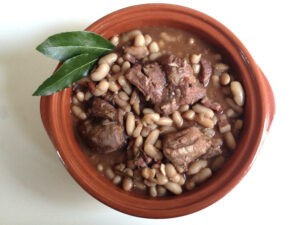
French lamb and beans
This very traditional French dish is like a cassoulet, but with lamb instead duck or goose. White beans are cooked to tenderness and then simmered with lamb, onion, bacon, tomato and herbs to produce a succulent dish that is ideal in cold weather.
For best results, ask your butcher for a deboned shoulder of lamb with most of the fat trimmed away — and, if possible, take home the bones as well. Any dried white beans may be used, for example Great Northern or navy beans in the States, or lingots in France. For the bacon, use a slab 2/5 inch (1 cm) thick, or if that’s not available use 2-3 thick slices.
This dish is tastiest if prepared a day ahead of time as the flavors will settle and intensify overnight. And the recipe, although simple, does take time. You will need at least an hour to soak the beans, about an hour to cook them and another 90 minutes to sauté the lamb, combine everything and simmer until ready.
The quantities below will serve 5-6 people.
2-3/4 cup (500 g) dried white beans (see above)
2-3 onions
2 cloves
1 carrot
1 branch celery
1 bay leaf
6 sprigs thyme
3 tsp. sea salt or table salt
1 shoulder of lamb, about 2-1/2 pounds (1.2 kilos) when deboned
1 tbsp. olive oil
1 tbsp. (15 g) butter
1 slab or 2-3 thick strips bacon (see above)
2 cloves garlic
1 cup (1/4 liter) dry red wine
1/2 small can whole peeled tomatoes
1 tbsp. tomato paste
1 branch rosemary
freshly ground black pepper
Begin by soaking the beans. You can soak them in cold water overnight or do it the quick way: Measure the beans into a sieve, rinse, transfer to a large bowl. Bring two quarts (liters) of water to a boil. Pour over the beans. Allow to soak for one hour.
Transfer the beans and their water to a large pot. Add more water — the surface of the water should be about 1 inch (2.5 cm) higher than the surface of the beans. Bring to a boil.
While the beans are heating, prepare the veggies. Peel one onion, chop off the ends, slice a cross into the top, insert two cloves and add to the beans. Peel the carrot and add. Rinse and trim the celery and add. Add the bay leaf and 3 sprigs of thyme. Important: do not add salt at this point, as it would harden the beans.
When the beans come to a boil, turn down the heat and simmer for about an hour, until the beans are tender but still a little al dente. Turn off the heat. Add 2 tsp. sea salt and stir. When cool enough to handle, remove the vegetables and thyme.
You will now turn your attention to the meat. Chop the lamb into large cubes, about 2 inches (5 cm) per side, removing as much fat as possible as you go.
Heat the olive oil and butter to sizzling in a large skillet. Add the lamb. Sauté, turning the meat over from time to time, until all the meat is well browned, about 15 minutes.
While the lamb is browning, prepare the other ingredients. Peel and finely mince one large or two medium onions. Chop the bacon into thick matchsticks (lardons). Peel and finely mince the garlic. Chop up half a tin of tomatoes, reserving the rest for another use. Measure the tomato paste into a small cup. Stir in about 2 tbsp. water to liquify it.
When the meat is well browned, transfer into the bean pot.
In the hot skillet, sauté the onions and bacon for 2 minutes, add the garlic and sauté 2 minutes more. Transfer to the bean pot. Add half a cup of water to the skillet and scrape the bottom to collect all the lovely browned bits. Add to the bean pot.
Set the bean pot over medium-high heat. Add the wine. Add the chopped tomatoes and the tomato paste. Stir. If you have lamb bones, add them now. Add the rosemary and the remaining three branches of thyme. Add 1 tsp. sea salt. Grind on some black pepper. Stir.
When the pot comes to a boil, turn down the heat. Make sure the beans are fully immersed in liquid — if there’s not enough, top up with water. Simmer for one hour. (While the dish is cooking, the liquid will reduce and thicken. Do not top up again.)
When the beans have cooked for an hour, turn off the heat. Allow to cool. Remove the lamb bones and the thyme sprigs.
At this point the dish needs to be simmered for 30 minutes more, either on the stove top or in a medium-hot oven (gas mark 6, 350 F, 180 C). If you prefer, you can refrigerate it overnight simmer for 30 minutes more the next day — the flavors will intensify.
Serve accompanied by a green salad, some crusty bread and a good bottle of red, perhaps a Bordeaux or a Côtes du Rhone. Serves 5-6.
This dish freezes well, so if you have any leftovers pop them in the freezer — you’ll have another day’s meal ready to go.




